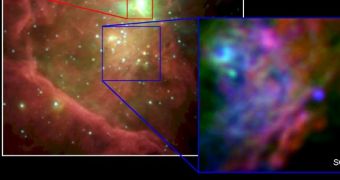A team of astronomers from Cornell University, led by principal investigator Terry Herter, was recently able to use data collected by the Faint Object Infrared Camera for the SOFIA Telescope (FORCAST) instrument aboard the NASA/DLR Stratospheric Observatory for Infrared Astronomy (SOFIA) aircraft to map the distribution of dust and stars in the famous Orion nebula.
The patterns in which interstellar gas is distributed in a nebula have significant ramifications on how fast and often that particular stellar nursery will produce young, blue stars. For the new study, the team focused on a section of the Orion nebula called Messier 42 (M42), which is a stellar nursery astronomers know well.
FORECAST captured two images of the object in mid-infrared frequencies, which are well suited to reveal the exact distribution of the dust. The reason this study was conducted in infrared is that interstellar dust releases this type of light when heated from within by freshly-formed stars.
The two photographs were collected during an observations campaign carried out between May and June, 2011. In charge of the study was SOFIA staff scientist James De Buizer. Each photo is covered in detail in its own scientific paper, both submitted for publication to the Astrophysical Journal.
SOFIA is able to conduct this type of investigations due to the fact that it consists of a 2.5-meter (100-inch) telescope mounted inside a heavily-modified Boeing 747SP aircraft. The latter is capable of flying at up to 13.5 kilometers (45,000 feet) above Earth's surface, an altitude that puts the aircraft well above 99 percent of water vapors in the atmosphere.
These vapors are a nuisance and a hindrance for both infrared- and optical-wavelength observations. SOFIA is able to get past that by simply flying over these particles. In addition, it can conduct infrared studies over places that are usually too cloudy to support the construction of a ground-based telescope.
The image above clearly shows that the airborne observatory is capable of making out even individual protostars in M82. These objects are immature stars, which have not yet undergone the gravitational contraction process required to collapse into mature celestial fireballs.
The blue inset box above shows a region of intense infrared emissions called the Ney-Allen Nebula, which was first discovered by astronomers Ed Ney and David Allen. The formation surrounds the luminous Trapezium stars and features dust and gas disks around very young Sun-like stars.
FORECAST collected this image at 8, 20, and 37 microns, which suggests that material in the NAN is heated up to around 500 Kelvins (226ºC or 450ºF).

 14 DAY TRIAL //
14 DAY TRIAL //